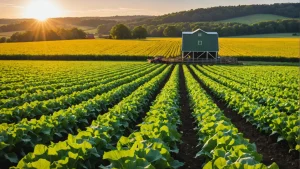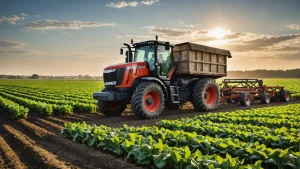In the competitive world of online farming, simply having a website is no longer enough to drive sales and grow your business.
To truly succeed in 2024, you need a comprehensive strategy that combines cutting-edge marketing techniques, e-commerce best practices, and a deep understanding of your target audience.
In this ultimate guide, we’ll walk you through proven tactics and practical tips to boost your online farm sales, increase website traffic, and build a thriving digital presence.
From crafting a compelling brand story to leveraging the power of social media and optimizing your online store for conversions, you’ll discover the secrets to taking your farm business to new heights in the digital age.

Metrobi has been a game changer for farm industry.
With Metrobi, you can save 23% on delivery costs, save 80% of the time from managing deliveries, and delight your customers with delivery notifications & tracking.
Online Farm Marketing Strategies to Skyrocket Your Sales
In today’s digital age, having a strong online presence is crucial for farms looking to increase their sales and reach a wider customer base. By implementing effective online marketing strategies, you can showcase your farm’s unique story, engage with potential customers, and ultimately drive more sales. At Metrobi, we support this journey by offering delivery services across more than 20 U.S cities, which includes our courier service in Boston, aiding farms in expanding their distribution efficiently.
Half of Farmers Buy Online
50% of farmers and growers are comfortable purchasing agricultural products online.
Build a Compelling Farm Website
Your farm website serves as the digital storefront for your business, and it’s essential to make a great first impression. A well-designed website should:
Showcase your farm’s unique story and values
Share the history of your farm, the passion behind your work, and the values that guide your farming practices. This helps customers connect with your brand on a personal level and understand what sets you apart from other farms. Elevate your agricultural email marketing efforts by sharing your farm’s unique story and principles, drawing customers closer and distinguishing your brand in their minds.
Feature high-quality photos and videos of your products
Visuals play a significant role in attracting customers and conveying the quality of your products. Invest in professional photography and videography to showcase your farm’s produce, livestock, and daily operations. This gives potential customers a glimpse into the care and dedication that goes into your farming practices.
Optimize your website for search engines (SEO)
To attract organic traffic to your website, it’s crucial to optimize your site for search engines. This involves researching relevant keywords, creating informative and engaging content, and ensuring your website’s structure and navigation are user-friendly. By improving your website’s SEO, you increase the likelihood of potential customers finding your farm online.
SEO Boosts Traffic
Implementation of SEO strategies has been proven to increase organic website traffic by an average of 112%.
Leverage Social Media Platforms
Social media platforms offer a powerful way to connect with your target audience, share your farm’s story, and promote your products. To make the most of social media:
Create engaging content showcasing your farm life and products
Share behind-the-scenes glimpses of your farm, highlight your product’s unique features, and offer valuable tips and recipes featuring your produce. Consistently posting interesting and informative content helps keep your followers engaged and more likely to purchase from your farm.
Use platforms like Facebook, Instagram, and Pinterest
Each social media platform has its own strengths and audience demographics. Facebook is great for building a community around your farm, Instagram is ideal for sharing visually appealing photos and videos, and Pinterest is perfect for showcasing recipes and lifestyle content related to your products. Tailor your content to each platform to maximize your reach and engagement. At Metrobi, we specialize in enhancing the distribution of agricultural products, making it easier for farms to connect with their market efficiently.
Engage with your followers and build a loyal community
Respond to comments, messages, and reviews promptly and professionally. Encourage your followers to share their experiences with your products and engage in conversations. Building a loyal community around your farm creates a sense of belonging and encourages repeat business.
Implement Email Marketing Campaigns
Email marketing allows you to stay in touch with your customers, keep them informed about your farm’s latest offerings, and encourage repeat purchases. To create effective email marketing campaigns:
Build an email list of customers and potential clients
Encourage website visitors and social media followers to sign up for your email list by offering exclusive content, promotions, or a free resource like a recipe book featuring your products. Growing your email list helps you reach a targeted audience of interested customers.
Send regular newsletters featuring new products, promotions, and farm updates
Keep your subscribers engaged with informative and visually appealing newsletters. Share updates about new product offerings, seasonal promotions, and exciting developments on your farm. Consistently providing value to your subscribers keeps your farm top-of-mind and encourages them to make purchases.
Segment your email list for targeted marketing
Not all customers have the same interests or purchasing habits. Segment your email list based on factors like past purchases, location, or expressed interests. This allows you to create more personalized and relevant email campaigns, increasing the likelihood of conversions and customer satisfaction.
By implementing these online farm marketing strategies, you can effectively reach and engage with your target audience, showcase your farm’s unique offerings, and ultimately boost your online sales. Remember to consistently provide value, build relationships with your customers, and adapt your strategies as your farm and the digital landscape evolve.

With Metrobi, you can save 23% on delivery costs.
Metrobi provides you with a competitive driver pool, a dedicated operations manager, and included delivery management software. We decrease your overall costs by 23%.
Farm E-commerce Best Practices to Boost Online Sales
Create a User-Friendly Online Store
Designing an intuitive and visually appealing online store is crucial for attracting and retaining customers. Start by choosing a reliable e-commerce platform such as Shopify or WooCommerce, which offers customizable templates and robust features. Organize your products into clear categories and subcategories, making it easy for customers to find what they’re looking for.
Provide detailed product descriptions that highlight the unique features and benefits of your farm produce. Use high-quality images showcasing your products from various angles, allowing customers to visualize their purchases. Consider including customer reviews and ratings to build trust and credibility.
Offer Convenient Payment and Shipping Options
To cater to diverse customer preferences, offer a variety of payment methods such as credit cards, PayPal, and digital wallets. Display accepted payment options and ensure a secure checkout process to build trust and encourage completed transactions.
Provide transparent shipping information, including rates, estimated delivery times, and any available expedited options. Consider offering free shipping for orders above a certain threshold to incentivize larger purchases. For nearby customers, provide local pickup or delivery options to enhance convenience and reduce shipping costs.
Implement Upselling and Cross-Selling Techniques
Upselling and cross-selling techniques can significantly increase your average order value and overall sales. During the sale and checkout process, suggest related products that complement the items in the customer’s cart. For example, if a customer is purchasing tomatoes, recommend basil or mozzarella cheese for a classic Caprese salad.
Create product bundles or gift baskets featuring a curated selection of your farm’s offerings. These pre-assembled sets provide convenience for customers and expose them to a wider range of your products. Offer discounts for bulk purchases or incentivize repeat customers with loyalty programs or exclusive promotions.
Leverage Personalized Recommendations
Utilize customer data and browsing behavior to provide personalized product recommendations. Implement a “Customers who bought this also bought” section to showcase relevant items based on purchase history. Send targeted email campaigns featuring products that align with a customer’s preferences, increasing the likelihood of additional sales.
For instance, a successful upselling and cross-selling campaign by a farm in the agriculture industry is the “Farm Fresh Bundle” sold by Green Thumb Farms, which increased the average order value by 25%.
Prioritize Customer Service and Engagement
Exceptional customer service is key to fostering long-term relationships and encouraging repeat purchases. Provide multiple channels for customer support, such as email, phone, and live chat, ensuring prompt and helpful responses to inquiries or concerns. Engage with customers through social media, responding to comments and messages in a timely and friendly manner.
Regularly seek customer feedback through surveys or post-purchase emails to identify areas for improvement and gather valuable insights. Incorporate customer suggestions and address any issues promptly, demonstrating your commitment to their satisfaction. Encourage satisfied customers to leave reviews on your website or third-party platforms to build social proof and attract new buyers.
Proven Tactics to Increase Farm Website Traffic
Collaborate with Local Businesses and Influencers
Partnering with local restaurants, farmers’ markets, or food bloggers can be a powerful way to drive traffic to your farm website. By offering exclusive discounts or promotions through these partnerships, you can tap into their established audiences and attract new customers to your online store.
Chris Boeckerman, a successful small farm owner in Oregon, shares his experience: “Collaborating with local restaurants has been a game-changer for our farm. We provide them with fresh, high-quality ingredients, and in return, they feature our farm on their menus and social media. It’s a win-win situation that has significantly increased our website traffic and online sales.”
Invest in Paid Advertising
Paid advertising, such as Google Ads or social media advertising, can be an effective way to target potential customers and drive them to your farm website. By creating compelling ad copy and visuals that showcase your products and unique selling points, you can attract the right audience and increase your online sales.
According to a recent study by the National Farmers Union, “Farms that invested in paid online advertising saw an average increase of 35% in website traffic and a 27% increase in online sales compared to those that did not.”
Participate in Online Forums and Communities
Engaging in online forums and communities related to farming, sustainability, or local food can help you build relationships with potential customers and industry peers. By sharing your expertise and providing value to these communities, you can establish your farm as a trusted authority and drive traffic back to your website.
Human Sources Are Essential for Farmer Product Decisions
Farmers prioritize human sources like agronomists and peer farmers for initial product research and brand comparison, with 50-60% valuing their advice.
Jenna Thompson, a marketing consultant for small farms, advises: “Participating in online forums and communities is a great way to connect with potential customers and build brand awareness. When you consistently provide helpful information and engage in meaningful discussions, people naturally become interested in learning more about your farm and what you have to offer.”
By implementing these proven tactics to increase your farm website traffic, you can attract more potential customers, boost your online sales, and ultimately make your farm more profitable. Remember to consistently monitor your efforts and adapt your strategies based on the results to ensure long-term success.
Harnessing the Power of Farm Social Media Marketing
Social media has become an essential tool for businesses of all sizes, including farms looking to boost their online sales. By developing a strong social media presence, you can engage with your target audience, build brand awareness, and drive traffic to your farm’s website. In this section, we’ll explore proven strategies for harnessing the power of social media marketing to grow your farm business.
Develop a Consistent Brand Voice and Aesthetic
Establishing a consistent brand voice and aesthetic across all your social media platforms is crucial for creating a recognizable and memorable brand. This helps your audience instantly identify your content and associate it with your farm.
Create a style guide for your social media posts
To maintain consistency, develop a style guide that outlines your farm’s brand colors, fonts, and imagery. This guide should also include guidelines for your brand’s tone of voice, ensuring that all your social media posts align with your farm’s values and mission.
Use consistent colors, fonts, and imagery across all platforms
Implement your style guide across all your social media profiles, including profile pictures, cover photos and post templates. Consistency in your visual branding helps create a cohesive and professional appearance, making your farm more memorable to your audience.
Create a Social Media Content Calendar
Planning your social media content is key to maintaining a consistent posting schedule and ensuring that your content is diverse and engaging.
Plan your posts to maintain a consistent posting schedule
Use a social media content calendar to plan your posts at least a month in advance. This allows you to create a balance of educational, promotional, and behind-the-scenes content that keeps your audience engaged and informed.
Mix educational, promotional, and behind-the-scenes content
Provide value to your audience by sharing educational content related to your farm’s products, such as recipes, cooking tips, or information about the health benefits of your produce. Promote your products and sales, but do so in a way that feels authentic and not overly salesy. Share behind-the-scenes glimpses of life on your farm to build a personal connection with your audience.
Use a social media management tool to streamline your efforts
Invest in a social media management tool like Hootsuite, Sprout Social, or Buffer to streamline your social media efforts. These tools allow you to schedule posts in advance, monitor your social media metrics, and engage with your audience across multiple platforms from a single dashboard.
Engage with Your Audience
Building a strong relationship with your audience is essential for fostering brand loyalty and encouraging word-of-mouth marketing. Engage with your followers regularly to create a sense of community around your farm brand.
Respond to comments and messages promptly
Monitor your social media profiles for comments, questions, and messages from your audience. Respond promptly and professionally, addressing any concerns or inquiries promptly. This shows your audience that you value their input and are dedicated to providing excellent customer service.
Ask for feedback and opinions to foster a sense of community
Encourage your audience to share their thoughts and opinions by asking questions in your social media posts. This can be as simple as asking them to share their favorite way to prepare your farm’s products or inviting them to vote on new product ideas. By actively seeking your audience’s input, you make them feel valued and invested in your brand.
Share user-generated content (with permission) to showcase customer loyalty
When your customers post about your farm or products on their social media profiles, reach out and ask for permission to share their content on your profiles. User-generated content serves as powerful social proof, showcasing the loyalty and satisfaction of your existing customers to potential new customers.
Leverage Social Media Advertising
While organic reach on social media can be limited, social media advertising allows you to target specific demographics and interests to reach new potential customers.
Define your target audience and create buyer personas
Before launching any social media advertising campaigns, take the time to define your target audience and create detailed buyer personas. This will help you craft ad content that resonates with your ideal customers and select the most effective targeting options.
Experiment with different ad formats and platforms
Each social media platform offers a variety of ad formats, such as photo ads, video ads, and carousel ads. Experiment with different formats to see which ones perform best with your target audience. Additionally, test advertising on different platforms to determine which ones yield the highest return on investment for your farm.
Collaborate with Influencers and Other Brands
Partnering with influencers and other brands can help expose your farm to new audiences and lend credibility to your brand.
Identify relevant influencers in your niche
Research influencers in the food, agriculture, and sustainability niches to find those whose values align with your farm’s mission. Look for influencers with engaged followings who regularly post about topics related to your products.
Develop mutually beneficial partnerships
Reach out to influencers and propose collaboration ideas that benefit both parties. This could include sponsored posts featuring your products, giveaways, or even an influencer visit to your farm. Be sure to clearly outline your expectations and compensation terms to ensure a smooth partnership.
By implementing these social media marketing strategies, you can effectively harness the power of social media to grow your farm’s online presence and boost sales. Remember to consistently monitor your social media metrics and adjust your strategy as needed based on performance and audience feedback.
Key Components of Online Farm Marketing
A Professional Website
A well-designed website serves as the foundation of your online farm marketing efforts. It should provide a clear overview of your farm, products, and values. Key elements include:
High-quality images and videos showcasing your farm and products.
Detailed product descriptions and pricing information.
About us page sharing your farm’s history, mission, and team.
Contact information and location details.
Responsive design for optimal viewing on mobile devices.
Social Media Presence
Social media platforms like Facebook, Instagram, and Twitter offer valuable opportunities to connect with potential customers, share updates about your farm, and build a loyal community. To maximize your social media presence:
Choose platforms that align with your target audience demographics.
Post regularly with a mix of informative, entertaining, and promotional content.
Engage with followers by responding to comments and messages promptly.
Use relevant hashtags to increase visibility and reach.
Collaborate with influencers or other farms for cross-promotion.
Email Marketing Campaigns
Email marketing allows you to nurture leads, promote new products, and keep customers engaged with your farm. To create effective email campaigns:
Build a targeted email list through website sign-ups, events, or purchases.
Segment your list based on interests, location, or purchase history.
Craft compelling subject lines and email content that provides value.
Personalize emails with the recipient’s name and relevant product recommendations.
Include clear calls-to-action (CTAs) to encourage purchases or website visits.
Analyze email metrics like open rates and click-through rates to optimize future campaigns.
E-commerce Functionality
To facilitate online sales, your website should have e-commerce capabilities. This includes:
Secure payment processing through trusted gateways like PayPal or Stripe.
Clear shipping and return policies to build trust with customers.
Integration with inventory management systems to avoid overselling.
Offering various shipping options and pricing based on location and speed.
Providing order tracking information for transparency and peace of mind.
By implementing these key components of online farm marketing, you can effectively showcase your products, reach a wider audience, and drive sales growth for your agricultural business. In the next section, we’ll dive deeper into understanding farm e-commerce and how to optimize your online store for success.
Understanding Farm E-commerce
Benefits of Selling Farm Products Online Through Farm Equipment Auctions
Selling farm products online opens up a world of opportunities for farmers. By embracing e-commerce, you can reach customers far beyond your local area, tapping into new markets and expanding your customer base. Online sales provide convenience for customers who prefer the ease of shopping from their devices, allowing them to purchase your products anytime, anywhere. Metrobi offers a solution that streamlines the delivery operations for farms, ensuring a reliable and efficient delivery service for agricultural products.
Farmers Rely on Digital Research
53% of farmers rely on digital interactions when researching products.
One of the most significant advantages of selling online is the potential for increased sales. With 24/7 availability, your products are accessible to customers around the clock, enabling you to generate revenue even while you sleep. By removing the limitations of traditional retail hours, you can capitalize on impulse purchases and cater to customers with varying schedules.
Digital Adoption
43% of small farmers plan their next season and make repurchases over digital channels, compared to just 20% of larger farmers.
Leveraging online auctions, such as those featuring John Deere and other high-demand tillage equipment, offers farmers an efficient way to sell farm products and equipment. With the convenience of bidding through a browser at any time, farmers can maximize their reach by participating in upcoming auctions. Farm equipment auctions eliminate geographical constraints, allowing for a broader audience and potentially higher returns through each auction.
Moreover, selling online can help reduce costs associated with traditional retail sales. You can save on expenses such as rent, utilities, and staffing by eliminating the need for a physical storefront. This cost-saving aspect allows you to allocate more resources toward product development, marketing, and customer service, ultimately enhancing your online presence and driving sales growth.
Challenges and Considerations
While selling farm products online presents numerous benefits, it also comes with its own set of challenges and considerations. One of the primary concerns is ensuring product freshness and quality during shipping. Unlike non-perishable goods, farm products often require special handling and packaging to maintain their integrity during transit.
To address this challenge, farmers must invest in appropriate packaging materials and develop efficient shipping processes. This may involve partnering with reliable shipping carriers, implementing temperature-controlled packaging, and establishing strict quality control measures. By prioritizing product freshness and quality, you can build trust with your customers and encourage repeat purchases.
Another consideration is managing inventory and order fulfillment. As your online sales grow, it becomes increasingly important to have a robust inventory management system in place. This includes accurately tracking stock levels, predicting demand, and ensuring timely order processing and shipping. Investing in inventory management software or partnering with a fulfillment service can streamline these processes and help you scale your online farm business effectively.
Investing in Technology and Marketing
To succeed in farm e-commerce, investing in technology and marketing is crucial. A well-designed website serves as the foundation of your online presence, providing a user-friendly platform for customers to browse and purchase your products. Consider incorporating features such as secure payment gateways, easy navigation, and mobile responsiveness to enhance the customer experience.
In addition to a robust website, investing in digital marketing strategies can help drive online sales. This may include:
Search engine optimization (SEO) to improve your website’s visibility in search results
Social media marketing to engage with customers and promote your products
Email marketing to nurture customer relationships and encourage repeat purchases
Paid advertising, such as Google Ads or Facebook Ads, to target specific audiences and drive targeted traffic to your website
Key Revenue Drivers
Search engine advertising, primarily through platforms like Google Ads and Bing Ads, accounts for 40% of online revenue.
By allocating resources to technology and marketing, you can create a compelling online presence, attract potential customers, and ultimately boost your online farm sales.
Measuring and Analyzing Your Online Farm Marketing Success
Set Clear Goals and KPIs
Before diving into measuring and analyzing your online farm marketing success, it’s crucial to establish well-defined goals. These goals should be specific, measurable, attainable, relevant, and time-bound (SMART). Examples of goals could include increasing website traffic by 25% within the next quarter, boosting online sales by 15% year-over-year, or improving email open rates by 5% over the next six months.
Once you have your goals in place, identify the key performance indicators (KPIs) that will help you track progress toward those goals. KPIs for an online farm business might include website traffic, conversion rates, customer acquisition costs, average order value, and customer lifetime value. Utilizing a sales team tracking app can further enhance your ability to monitor performance, track sales representatives’ activities, and improve efficiency. By regularly monitoring these metrics, you can gain valuable insights into the effectiveness of your marketing efforts and make data-driven decisions to optimize your strategies.
Use Analytics Tools
To effectively measure and analyze your online farm marketing success, you need the right tools. Google Analytics integration with Salesforce is a powerful, free tool that allows you to monitor website performance, track user behavior, and gain insights into your audience demographics. By setting up goals and events in Google Analytics, you can track conversions, such as purchases or email sign-ups, and identify areas for improvement on your website.
Social media analytics tools, such as those built into Facebook, Instagram, and Twitter, can help you track engagement, reach, and follower growth. These insights can guide your content strategy and help you better understand your target audience’s preferences and behaviors.
For email marketing, use the analytics provided by your email service provider to monitor open rates, click-through rates, and conversions. This data can help you optimize your subject lines, content, and calls-to-action to improve the effectiveness of your email campaigns.
Continuously Optimize Your Strategies
Measuring and analyzing your online farm marketing success is an ongoing process. Regularly review your analytics data to identify trends, successes, and areas for improvement. Use this information to test different strategies and tactics, such as adjusting your ad targeting, experimenting with new content formats, or optimizing your website’s user experience.
Stay up-to-date with the latest trends and best practices in online marketing by following industry blogs, attending webinars, and participating in online communities. By continuously learning and adapting your strategies, you can stay ahead of the competition and maximize your online farm marketing success.
Addressing Farm Efficiency and Profitability
While measuring and analyzing your online farm marketing success is crucial, it’s also important to consider the overall efficiency and profitability of your farm. Here are some strategies to help make your farm more efficient and successful:
-
1Streamline operations: Analyze your current processes and identify areas where you can reduce waste, minimize downtime, and increase productivity. This may involve investing in new equipment, automating tasks, or reorganizing your workflow. Metrobi supports farms by offering delivery services across more than 20 US cities, featuring courier services in Chicago, to enhance their operational efficiency.
-
Diversify your products: Consider expanding your product offerings to include value-added products, such as jams, sauces, or baked goods, which can help increase your revenue streams and appeal to a wider range of customers.
-
Implement sustainable practices: Adopting sustainable farming practices, such as crop rotation, cover cropping, and integrated pest management, can help improve soil health, reduce input costs, and increase long-term profitability.
-
Collaborate with other farmers: Partnering with other local farms can help you share resources, pool marketing efforts, and access new markets. Consider joining a cooperative or participating in a community-supported agriculture (CSA) program to expand your reach and reduce costs. Explore how partnerships between farms can elevate your agricultural business by unlocking shared benefits and opportunities.
By focusing on both online marketing success and overall farm efficiency, security and profitability, you can build a thriving, sustainable business that stands the test of time.
Your Farm’s Online Success Starts Today
By implementing these online farm marketing strategies, e-commerce best practices, and proven tactics, you can significantly boost your farm’s online sales in 2024 and beyond.
Building a strong online presence through a compelling website, engaging social media content, and targeted email campaigns will help you reach a wider audience and establish your farm as a trusted brand.
Ready to take your farm’s online sales to the next level? Start by auditing your current online presence and identifying areas for improvement. Prioritize the strategies and tactics that align with your farm’s unique goals and resources.
Which online marketing strategy will you focus on first to drive more traffic and sales to your farm’s website? Share your thoughts and experiences in the comments below – we’d love to hear from you!


























